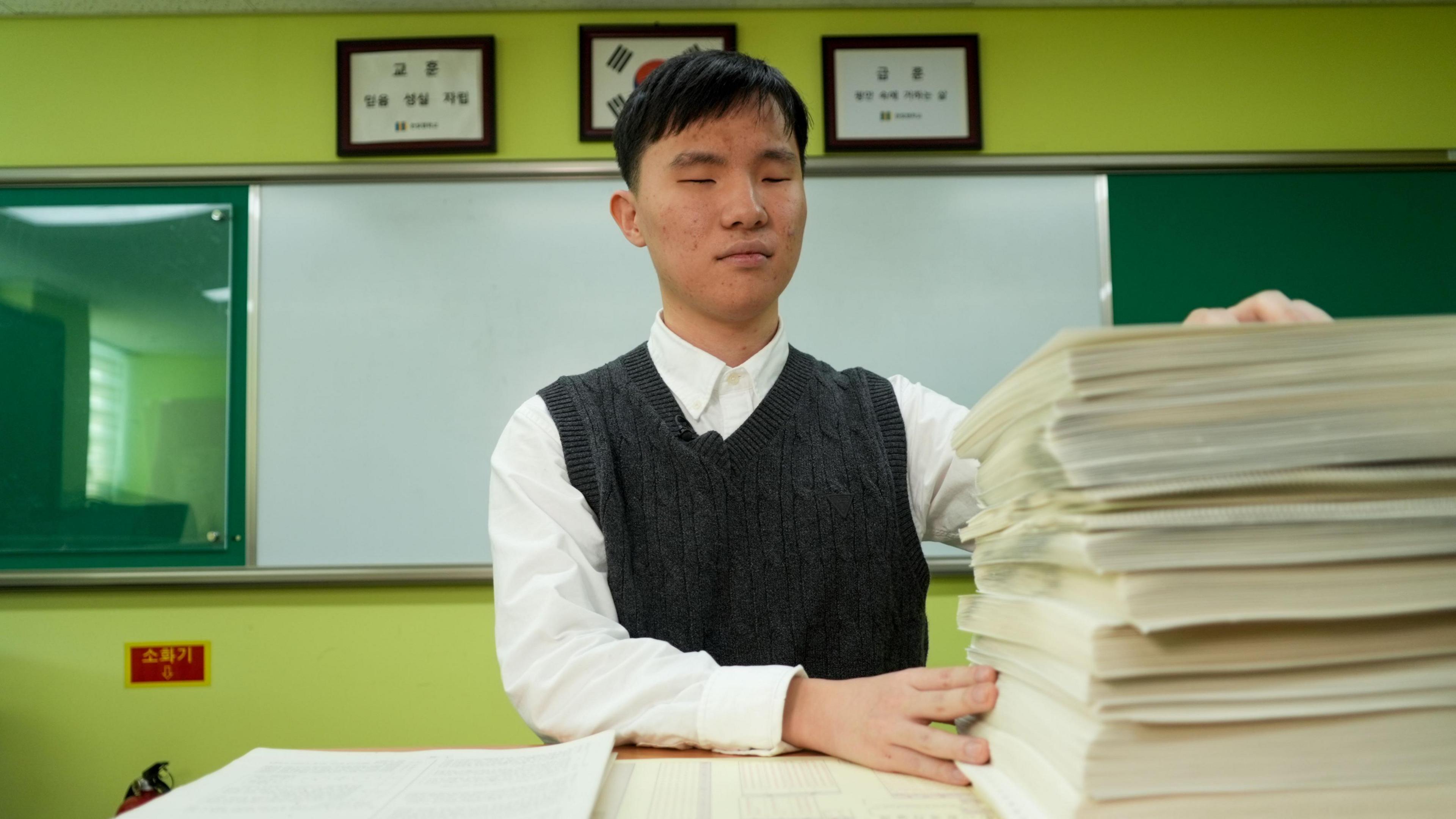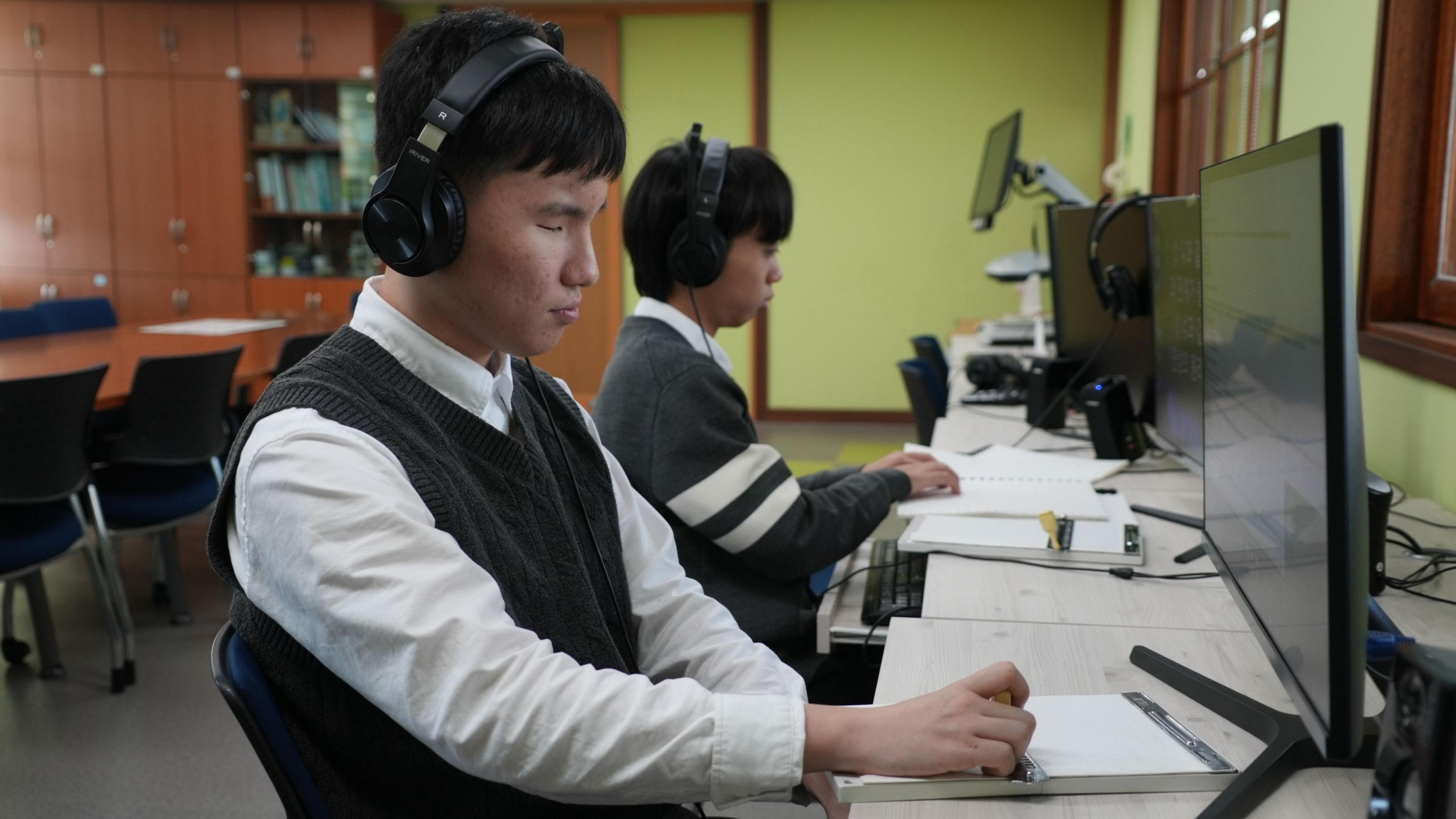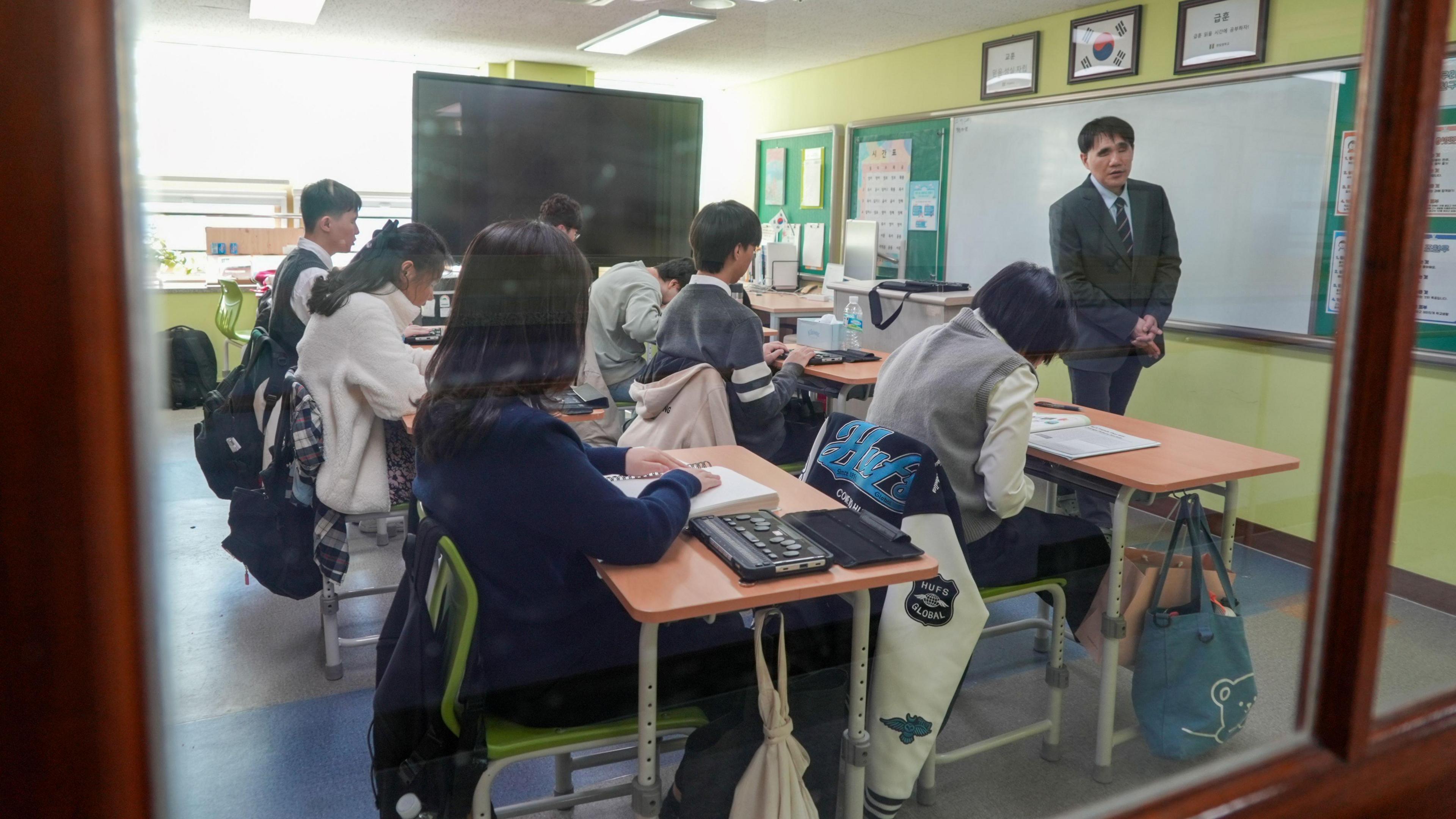Thirteen hours by touch – inside one of the world's longest exam days

Han Dong-hyun, a student at Seoul Hanbit School for the Blind, is among those who will take the "longest version" of the infamous Suneung exam
- Published
Every November, South Korea comes to a standstill for its infamous college entrance exam.
Shops are shut, flights are delayed to reduce noise, and even the rhythm of the morning commute slows down for the students.
By late afternoon, most test-takers walk out of school gates, exhaling with relief and embracing the family members waiting outside.
But not everyone finishes at that hour. Even once darkness has fully settled and night has set in, some students are still in the exam room - finishing close to 10pm.
They are the blind students, who often spend more than 12 hours taking the longest version of the Suneung.
On Thursday, more than 550,000 students across the country will sit for the Suneung - an abbreviation for College Scholastic Ability Test (CSAT) in Korean. It is the highest number of applicants in seven years.
The test not only dictates whether people will be able to go to university, but can affect their job prospects, income, where they will live and even future relationships.
Depending on their subject choices, students answer roughly 200 questions across Korean, mathematics, English, social or natural sciences, an additional foreign language, and Hanja (classical Chinese characters used in Korean).
For most students, it is an eight-hour marathon of back-to-back exams. They begin the Suneung test at 08:40 and finish around 17:40.
Blind students with severe visual impairments, however, are given 1.7 times the standard testing duration.
This means that if they take the additional foreign language section, the exam can finish as late as 21:48 - nearly 13 hours after it began.
There is no dinner break; the exam continues straight through.
The physical bulk of the braille test papers also contributes to the length.
When every sentence, symbol and diagram is converted into braille, each test booklet becomes six to nine times thicker than the standard equivalent.

The constant friction from reading braille for hours straight can make students' hands sore
At Seoul Hanbit School for the Blind, 18-year-old Han Donghyun is among the students who will take the longest version of the Suneung this year.
Last year, there were 111 blind test-takers nationwide - 99 with low vision and 12 with severe visual impairments like Dong-hyun - according to data from the Ministry of Education and the Korea Institute for Curriculum and Evaluation.
Dong-hyun was born completely blind and cannot distinguish light.
When the BBC met him at his school on 7 November, his fingers moved quickly across a braille practice booklet of past exam questions.
With just a week left before the test, he was focused on managing his stamina and condition. Dong-hyun will take the exam using braille test papers and a screen-reading computer.
"It's really exhausting because the exam is so long," he said. "But there's no special trick. I just follow my study schedule and try to manage my condition. That's the only way."
The day silence falls over South Korea
- Published26 November 2018
Pop hit APT too distracting for S Korea's exam-stressed students
- Published14 November 2024
Students sue after exam ends 90 seconds early
- Published20 December 2023
Dong-hyun said the Korean language section is particularly difficult for him.
A standard test booklet for that section is about 16 pages - but the braille version is roughly 100 pages long.
Even with screen-reading software, spoken information disappears as soon as it is heard, unlike text that can be seen and re-read. Dong-hyun has to hold the details in his memory as he goes.
The mathematics section is no easier.
He must interpret complex graphs and tables that have been converted into braille, using only his fingertips.
Still, he noted that things are better than they used to be. In the past, students had to do almost all calculations in their heads. But since 2016, blind test-takers have been allowed to use a braille notetaker, known as Hansone.
"Just like sighted students write out their calculations in pencil, we enter them in braille on the Hansone to follow the steps," he said.

Students like Oh Jeong-won must use braille display devices during the exam
Another student at Hanbit School for the Blind, 18-year-old Oh Jeong-won, who will also sit the Suneung this year, said the late afternoon is "the hardest point" of the day.
"Up until lunch, it's manageable," he said. "But around 4 or 5pm, after English and before Korean History, that's when it gets really tough.
"There's no dinner break," he explained. "We're solving problems during the time we would normally eat, so it feels even more exhausting. Still, I keep going because I know there will be a sense of accomplishment at the end."
For Jeong-won, the fatigue is compounded by the need to stay intensely focused with both his hands and his hearing.
"When I'm reading the braille with my fingers and also taking in information through audio, it feels much more tiring than it does for sighted students," he said.
But the students say that the length of the exam and the long study hours are not the hardest part. What is most challenging is access to study materials.
Popular textbooks and online lectures that sighted students rely on are often out of reach.
There are very few braille versions, and converting materials into audio requires having text files - which are difficult to obtain. In many cases, someone has to manually type out entire workbooks to make them usable.
Online lectures also pose difficulties, as many instructors explain concepts using visual notes, diagrams and graphics on screen, which cannot be followed through audio alone.

Ahead of the Suneung exam, Han Dong-hyun and Oh Jeong-won solve past questions using a screen reader and braille
One of the most significant barriers, however, is the delay in receiving braille versions of the state-produced EBS preparation books - a core set of materials closely linked to the national exam.
Because of this delay, blind students often receive the materials months later than others.
"Sighted students get their EBS books between January and March and study them for the whole year," said Jeong-won. "We receive the braille files only around August or September, when the exam is just a few months away."
Dong-hyun shared the same concern.
"The braille materials weren't completed until less than 90 days before the exam," he said. "I kept wishing the publication process could be faster."
The National Institute of Special Education, which produces the braille version of EBS exam materials, told the BBC that the process takes at least three months for each book because it must follow relevant guidelines.
The institute added that it is "making various efforts to ensure that blind students can study without disruption, such as producing and providing the materials in separate volumes."
The Korean Blind Union said it has long raised this issue with authorities, and plans to file a constitutional petition demanding greater accessibility to braille versions of all textbooks.

For blind students, the Suneung exam can last for more than 12 hours
For these students, the Suneung is not just a college entrance exam - it's proof of the years they have endured to get where they are.
Jeong-won described the exam as "perseverance."
"There's almost nothing you can do in life without perseverance," he said. "I think this time is a process of training my will."
Their teacher, Kang Seok-ju, watches students go through the exam every year - and said the blind students' endurance is "remarkable".
"Reading braille means tracing raised dots with your fingertips. The constant friction can make their hands quite sore," he pointed out. "But they do it for hours."
Mr Kang urged his students to value completion rather than regret.
"This exam is where you pour everything you've learned since the first grade into a single day," he said. "Many students feel disappointed afterwards, but I just want them to leave knowing they did what they could.
"The exam is not everything."